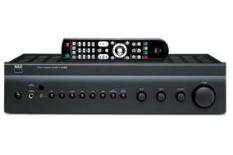The C326BEE could only be a NAD product. The traditional grey finish may have modulated from ‘battleship' to something a little more discreet, but few other manufacturers have the confidence/bloody-mindedness to evolve the looks of its electronics at such a glacial pace.
Where specification is concerned, though, NAD is happy to keep up with the times.
The C326BEE may be one of the few amplifiers in circulation with binding for just a single pair of loudspeakers, but it hits back with a fascia-positioned 3.5mm input as one of seven line-level connections, two of which are tape loops, and not one but two subwoofer pre-outs in case you find the sound a bit tentative in the lower reaches. We don't think you will, though.
Low frequencies impress
In fact, it's the low frequencies that immediately impress. Playing Joy Division's She's Lost Control, the NAD generates solid weight and presence at the bottom end – in fact, this trait informs the C326BEE's entire sound, which is much more a boxer's heavy bag than his speed-ball.
It has undoubted expertise in other areas – timing, in particular, is toe-tappingly expressive, there's fulminating dynamic potency on offer and it's especially revealing when given a well-recorded voice, with its fluid, organic midrange – but it's the scale and solidity of its bass reproduction that's the initial calling card.
You're never unaware of what else the C326BEE has to offer, though – where agility is concerned, for example, the this amp's giving nothing away, and it's happy to adapt to pretty much any genre of music you might throw at it – massed choral works, for example, are particularly revealing, allowing the NAD to demonstrate its punch and articulacy simultaneously.
In short, this amplifier remains as likeable and listenable as when we last formally tested it in May 2009. And yet it's lost a star in the interim. Here's why…
Rivals get to the bottom of it
Hell is other people, of course – or, in this instance, it's other manufacturers' amps. Stacked against the best of its new rivals, the NAD sounds a touch bottom-heavy – not to the detriment of timing, but rather at the expense of a neutral tonal balance.
It's far from a bad buy, though, and if a pocket powerhouse is what you want, it needs to be near the top of your shortlist.
See all our amplifier Best Buys
Follow whathifi.com on Twitter

